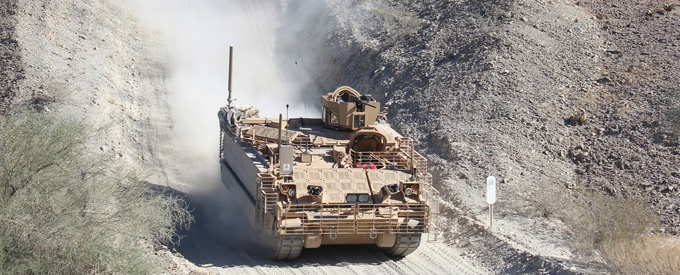2019-08-07
BAE Systems Begins LRP for AMPV Variants
The U.S. Army earlier this year awarded BAE Systems two contract modifications worth up to US$575 million for the low rate initial production of Armoured Multi-Purpose Vehicle (AMPV), which marks the beginning of low-rate production (LRP) phase. The AMPVs are designed to meet requirements of U.S. Army’s Armoured Brigade Combat Teams (ABCT).
One of the priorities of the U.S. Army, the AMPV programme is crucial for ABCT to fulfil its strategy of protection, mobility, reliability, and interoperability. The AMPV will operate alongside the M1 Abrams tank and the M2 Bradley. It addresses the inevitable need to replace the Vietnam War-era M-113s, which are still in service in a variety of support capacities. The M-113s lack the force, protection and mobility needed to operate as part of combined arms teams within complex operational environments. The majority of the Army’s M-113s are found in ABCTs, where they comprise around 32 per cent of the tracked armoured vehicles organic to the organisation.
AMPV Development Milestones
AMPV is a non-developmental programme, which means it is either existing vehicles or modified vehicles. According to experts, they might make it easier for the U.S. Army to eventually field this system to the force, as most of the Army’s past developmental programmes, such as the Ground Combat Vehicle (GCV), the Future Combat System (FCS), the Crusader self-propelled artillery system, and the Comanche helicopter, were cancelled before they could be fully developed and fielded.
The U.S. Army had issued a Request for Proposal (RFP) for the AMPV in November 2013, which stipulated the Army to award a five-year Engineering and Manufacturing Development (EMD) contract to a single contractor for 29 prototypes, planned for a worth of US$458 million. BAE System Land and Armaments L.P. won the initial EMD contract worth around US$386 million, with the successful Critical Design Review (CDR) completion on June 23, 2016. The first general purpose AMPV was delivered to the Army for testing in December 2016. The Army began reliability, availability, and maintainability (RAM) testing in September 2017, but the Army decided to upgrade a number of EAB M-113s instead of replacing them with AMPVs. However, later the army decided to put the EAB M-113 upgrade effort on hold.
The EMD contract provided for an optional low-rate initial production (LRIP) phase. The EMD phase was scheduled to run between FY 2015 and 2019, followed by three years of low-rate initial production (LRIP). As of 2018, the Army had planned to procure 2,936 AMPVs. The Army has plans to replace 1,922 M-113s at Echelons Above Brigade (EAB), and the Department of Defense (DOD) reportedly estimated if AMPVs replace M-113 at EAB, total programmes costs might increase by US$6.5 billion.
However, the Army leadership reportedly announced to cut funding for over 93 programmes to increase available funding for its new modernisation strategy. Even though this cut is not expected to affect the overall AMPV requirement, it might slow the AMPV production rate.
A Cost-Effective Matured Solution
The AMPV is a mature, low-risk and cost-effective solution that delivers combat overmatch capability for the Army. Its design leverages Bradley and M109A7 Self Propelled Howitzer modernisation and risk reduction investment that optimise mobility, vehicle electronics, and integrated mission equipment performance. These capabilities also deliver enhanced underbody protection. The AMPV is being built in five different configurations including the General Purpose, Mission Command, Mortar Carrier, Medical Evacuation, and Medical Treatment vehicles.
The AMPV provides better survivability with its reactive armoured tiles, common spall liner and applique, as well as enhanced underbelly protection and automatic fire suppression systems in crew and engine compartments. The AMPV capitalises on the proven Bradley and M0109A7 powertrain and suspension to provide all-terrain mobility. It aids manoeuvrability under close-in and urban combat by increasing driver’s field of vision. The AMPV offers control beyond-line-of-sight with improved network connectivity and digital satellite communications hardware and software.
The AMPV general purpose variant operates throughout the battlespace to conduct resupply, maintenance, alternate casualty evacuation (CASEVAC) and as the first sergeants’ vehicle for the Combined Arms Battalion. It can accommodate a driver, commander and four soldiers. For CASEVAC, the vehicle can be reconfigured to accommodate a supine litter casualty without interference or displacement of crew or equipment.
Bill Sheehy, AMPV programme director for BAE Systems’ combat vehicles business said, “Moving into this phase of the AMPV programme is exciting because it brings soldiers one step closer to deploying this critical capability for completing their missions and coming home safely. We have been preparing for this moment and are ready to take this programme to the next stage.” BAE Systems is a trusted supplier of combat vehicles to the U.S. military and allied nations and has an extensive manufacturing network across the U.S.
Reference Text/Photos: Congressional Research Service R43240, www.baesystems.com


No Comments